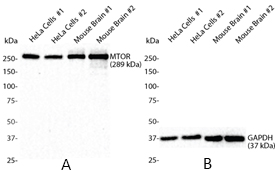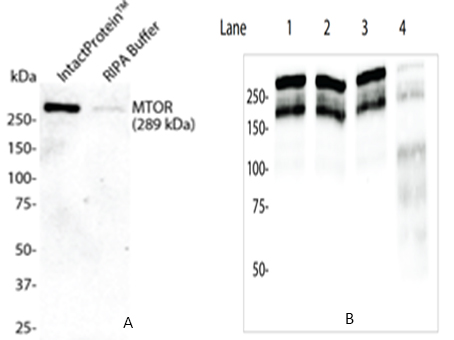KIT COMPONENT: Reagent A, Reagent B
DIRECTIONS:
1. Prepare the cell lysis buffer by adding 2 µL of Reagent A into 1 mL of Reagent B immediately before use. Mix well by vortexing. 2. For adherent cells, discard the medium, and wash cells twice with
ice-cold PBS. For suspension cells, pellet down the cells by centrifugation (200g for 5 min). Resuspend the cells in 10 mL of ice-cold PBS. Pellet down the cells again, discard the PBS, and resuspend the cells in the residual buffer by pipetting. 3. For adherent cells, keep the plate/dish on ice and add 1 mL of cell lysis buffer per 5x106 cells (e.g.
add 300 µL of lysis buffer to a 35mm dish). Keep the plate/dish on ice for an additional 5 min, swirling occasionally to spread the lysis buffer. For suspension cells, add 1 mL of cell lysis buffer per 5x106 cells directly to the resuspended cells. Mix by pipetting. 4. For adherent cells, after 5 min of lysis, scrap the cells off the plate/dish and collect the lysate in a centrifuge tube. 5. For both adherent and suspension cells, vortex the lysates (3 x 10 sec)and place the cells on ice for an additional 10 min to complete lysis. 6. Heat the lysates on a 95°C heat block for 5 min. 7. Cool the lysates on ice for 3 min. 8. Centrifuge the lysates at 13,000g for 5 min. 9. Measure the protein concentration using a NanoDrop spectrophotometer or an SDS_x0002_compatible protein assay method. 10. Store the cell lysates at -20°C or immediately use the lysates for further analysis. Note: For reducing gels, a final concentration of 2–5% β-mercaptoethanol or 50 mM DTT needs to be added to the lysates. The samples must be heated at 95°C for 5 min before loading.
DIRECTIONS FOR PROTEIN EXTRACTION FROM TISSUES::
1. Grind tissues into fine particles in liquid nitrogen with a mortar and pestle.
2. Add the tissue powder into the pre_x0002_mixed IntactProteinTM lysis reagent at the ratio of 1g of tissue to 3 mL of lysis reagent.
3. Homogenize the tissue using a homogenizer according to the manufacturer’s instructions. Tip: homogenization will heat up your sample, so always keep the tube on ice.
4. Incubate the tissue on ice for 15 min.Tip: If you deal with multiple samples, put all the samples on ice till you finish the last one. Count time from when the last sample is done.
Incubation time longer than 15 min will not affect the quality of the extracted proteins.
5. Centrifuge at 4°C for 10 min and transfer the supernatants into clean centrifuge tubes.
6. Follow steps 6-10 in the Directions for Protein Extraction from Cells





 Inquiry (MOQ:1000 units)
Inquiry (MOQ:1000 units)



